Here are details of the fish I have kept, from August 2001 to the
current day.
Last updated 4 January 2006.
Apple Snail
Pomacea
I bought this to keep the algae off my acrylic tank (algae scrapers
scratch acrylic) and to liven things up as company for my female
betta.
I used to have a plant. I don't any more!
A whole amazon sword, gone overnight!
|

|
Ancistrus Catfish
Ancistrus
A mini-pleco! He was just over an inch long (very small!) and hid
by day, but my algae mysteriously disappeared by night... after a
couple of days he had simply disappeared. I replaced him with a
slightly larger bristlenose which is hardier.
I am not sure exactly which ancistrus he was.
|
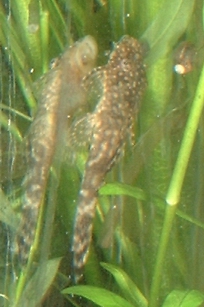
|
Angelfish
Pterophyllum scalare
I rescued a pair of angels when rehoming fish from a friend. They both
stayed in my tank temporarily before one was taken to a new home.
The second has a cloudy eye and so is shy and swims in circles. I was
hoping to treat that, before rehoming him - but his eye will not
clear up. He seems happy in the tank so I have decided to keep him.
Fortunately, he was brought up with tetras and so does not show interest
in eating them.
There are many types of Angel; this is a Gold Marble Angelfish.
|
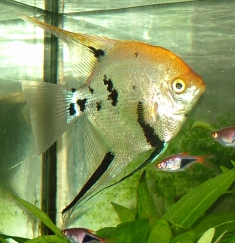
|
Striped Anostomus
Anostomus anostomus
These fish are real characters! I wanted something that would fit
with my "stripe" theme and hold their own with cichlids - anostomus
was recommended.
This chap will hide in the caves (poking his head out to look around
now and then), stand on his head to eat as he rootles through the
gravel... highly entertaining!
In January 2006 I returned him to my fish store as the remaining
fish were malawi cichlids and I wanted to restock the tank with
more cichlids. I hope he has a happy life in a community tank
elsewhere.
|

|
Axolotl
Ambystoma mexicanum
I have loved axolotls for ages so was delighted when given a tank
to be able to house some.
I have two wildtypes - one male, one female - and an albino female.
They live in a bare tank with just 6" of water, large sized gravel (so
they don't eat it), a shelter made from PVC drainpipe, and some floating
plants. I've added a piece of bogwood with java fern on it, as some more
shelter. However sharp edges in the tank should be avoided.
They eat minced beef, dangled in front of their mouths with tweezers, and
this has also trained them to look up for food rather than rootling through
the gravel and trying to eat it, as they were brought up on bloodworm.
They periodically lay eggs, but so far I have only managed to rear
them to a month old. I am hoping for better survival in later batches.
One is shown among the gravel in the photos, hiding at a few weeks old.
Shortly after this stage their back legs developed and they started
swimming.
Update: The male died suddenly in late 2005. The others are fine and I
will replace the male soon.
This is a page about the egg development and the latest babies.
|


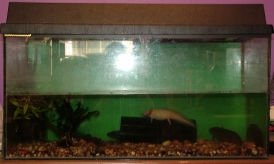

|
Betta (Siamese Fighting Fish)
Betta splendens
Betta fish are also known as Siamese Fighting Fish because, like cocks,
they can be bred for competition and will fight to the death. For this reason
you can only keep them singly - male and female should be separated
after breeding.
However they are easy to keep. They have developed an organ which allows
them to come to the surface to breathe air, as they live in mud puddles
in the wild. This allows them to tolerate harsher living conditions than
many other fish. I keep my betta in a small tank on his own, with live
plants and gravel from an established tank, with an overhead light which
also keeps the temperature up - but no filter
etc. All he needs are regular water changes, and occasional exercise by
holding up a mirror - he percieves a rival fish, and flares furiously.
When breeding they build nests of bubbles for eggs to go in. Happy Betta males
build bubble nests on their own.
My first is a male royal blue crown tail, with red wash. Although the
red colouring
is a "fault" in show Bettas, I chose mine because I liked the way he looks.
He has learnt to recognise me (though he flares at the cat and visitors),
builds bubble nests, comes to say hi when I go to the tank, and jumps to
take food from my fingers. I called him [B]Louis.
My second was a male red veiltail. He had blue colouration which showed
up when the light caught him. In normal light however, he looked Ferrari red,
hence the name Rubens! He refused to eat and died ten days after I bought him.
I replaced Rubens with two female bettas, one blue and one red with blue sheen
like Rubens. I called them Ruby and Zapphira. Ruby was sick from the store and
died the next day, and was replaced with a bright red fish (Ruby II) with no
blue sheen. This fish soon dropped dead as well, leaving Zapphira on her own.
The top two photos are of males, the others of the less showy females.
|
![[B]Louis: Royal blue crowntail betta splendens](betta/trailing.jpg)
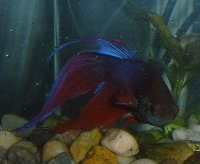
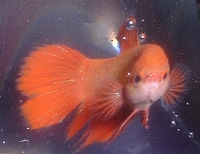
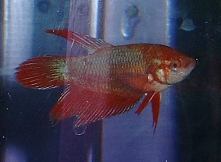
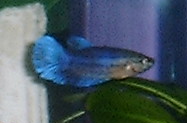
|
Black Neon Tetra
Hyphessobrycon herbertaxelrodi
These are gorgeous fish with black markings and a green neon stripe.
They like to swim lower down in the tank and are less active than the
tinier fish, although they enjoy swimming in a group and rummaging for food.
|

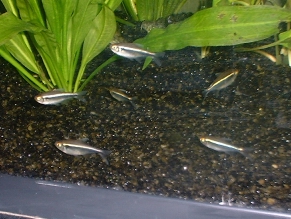
|
Black Ruby Barb
Barbus nigrofasciatus
Six black ruby barbs were bought to put into the new tank after adding
bacterial drops for a week, in order to mature the tank. They were
hardy and quite fun. They are peaceful and fast moving, and get on
with all the other fish very well. There was some confusion as to whether
these were clown barbs or tigers, but as they matured, the male four took
on red colouring, especially pronounced after being in the dark. This
identifies them clearly as black rubies.
After a few years they died off - I believe due to old age. The males
died before the females, who remained slightly hardier.
|

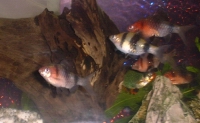
|
Bleeding Heart Tetra
Hyphessobrycon erythrostigma
I acquired one of these in a bunch of fish from someone who could no longer
keep fish. I'd like room for a few more of these but he seems to be managing
well as the only one in the tank.
The name is very descriptive, look at his colouring!
|

|
Blue Ram
Microgeophagus ramirezi
I bought two young rams in July 2003. They were about an inch long
and both male - I had hoped for a pair but females are rarely found
in the shops. Although no blue
spots were seen over the black stripe, the photo seems to show some.
This is likely to be the scales reflecting the camera's flash.
Spots over the black blotch indicate a female. Other methods of
sexing include the female having a less spikey third dorsal spine,
and having a red belly when mature.
More photos of my rams are here.
In January 2004 the smaller ram developed a growth on its head (which I
did not recognise as any kind of common fish disease) and died within
the week despite good water conditions, and all the other fish being
in good health.
In March 2004 I finally found the remaining ram a female friend,
but neither survived after I added a peacock cichlid to the tank.
|
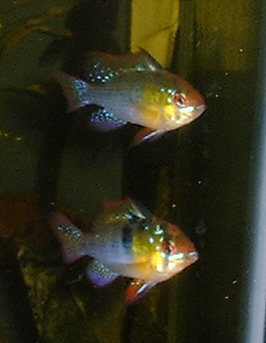

|
Bristlenose Ancistrus
Ancistrus temminckii
Another mini-pleco! This one is hardier and can be seen munching my
algae, or a tail sticking out from a bunch of leaves which are shaking
violently! Only males grow the bristles, so I know it's a chap. He's
doing a great job of keeping the tank tidy.
He has a lot of character and although he usually hides by day, he
will have a nose around when food is dropped in. He can go "missing"
for months, then suddenly a fat Bristle appears... One of my favourite
small fish.
|
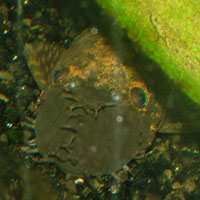
|
Cardinal Tetra
Paracheirodon axelrodi
Cardinals are sensitive, but beautiful fish. I have created a tank with
softer, neutral water in order to be able to keep them. They are fragile
so need looking after, but the blue and red stripes are gorgeous as they
dart about the tank. Distinguished from neon tetras by their longer red
stripe.
|

|
Clown Loach
Botia macracanthus
My clown loaches were initially shy and like to hide. However, as soon
as a piece of cucumber is dropped into the tank there they are,
zooming about and chomping. Cute little things, although they will
grow much larger over time. They had an initial spurt when added to
the tank (to 2" for the small ones and 5" for the large one) but
have stopped growing so quickly now.
They will eat plants, coconut fibre, algae wafers, cucumber... basically
anything that stands still long enough!
As a treat, I drop snails from the other tanks in, and watch the loaches
go nuts eating them.
|
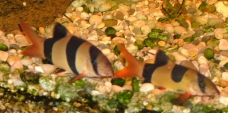
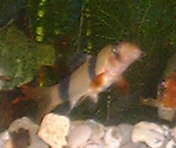
|
Clown Synodontis Catfish
Synodontis decorus
I have taken delivery of a friend's female syno, as she
was 7" and did not have enough room in their tank.
So far, she has not been seen out of her hiding place (she is
nocturnal and shy) but every morning, some gravel has been moved
to enable her to hide more comfortably, and she has turned round.
She pokes her head out (as in the photo) and I am hoping she will
become less shy as she gets used to her new home.
She is occasionally seen on early hours trips to the fridge, and
scuttles away as the fridge light reveals her! I believe she is
responsible for eating some small fish, too.
|

|
Cochu's Blue Tetra
Boehlkea fredcochui
The store had these mislabelled as scissortail rasboras, and told me they
would lose the blue colouration with maturity. A year later, they are still
blue!
Someone on a newsgroup helped me with the I.D. - due to the adipose fin
being present I can be fairly sure they are blue tetras.
They are more lively than most, but still small and very peaceful.
A beautiful fish.
|


|
Corydoras Catfish
Corydoras
My clean up crew! They hoover the gravel as a group, eating any flake that
falls to the bottom, and also the algae wafers that I feed them.
They are chomping through the plants too!
They are all different - two with patchy designs and one with solid
markings. Cory cats need to be in groups of three or more but they can
be different types, so I chose three which were different for easy
identification.
They are a little shy, but growing used to me. They are always hungry,
and rummaging for food.

|


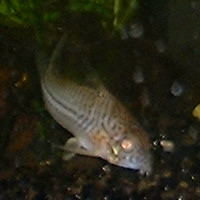
|
Danio
Brachydanio rerio (zebra), Brachydanio frankei (leopard)
I bought a clutch of danios when nothing would swim at the top of my
tank, and when I was looking for something new. They are compatible with
all my barbs and leave well alone.
Danios come in long and shortfin varieties, and leopard is a variant
of zebra (they can interbreed). Males have gold between their stripes,
females have silver.
Based on this, I have two male zebras and a female. The leopard is
probably also male. He chases the others, so although he is a close
relative to them, it might have been better not to choose him!
Danios are fast swimmers, fun, and often on show, so quite rewarding.
However they are small and thin - so liable to be eaten!
|
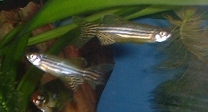
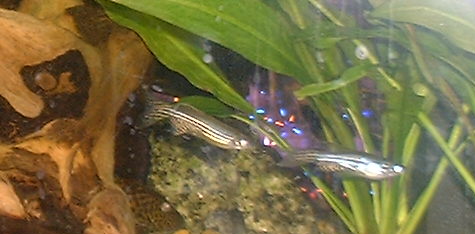
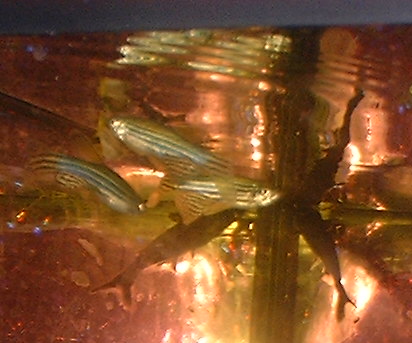
|
Elephant Nose
Gnathonemus petersi
I had one elephant nose fish, which I adored but he was very shy.
He stayed in hiding for a month, and despite tempting him with different
food types and ensuring some of them always reached him, he was found
dead. It's possible he starved.
Elephant's nose-like probe is used to send electricity to hunt prey, and to
root through the gravel for food. His strange body shape is due to
the large brain - a brain to body size ratio matched by humans.
|

|
Glowlight Tetra
Hemigrammus erythrozonus
I acquired one of these in a bunch of fish from someone who could no longer
keep fish. I bought him a couple of friends to keep him company, but all
of them are very shy.
He is small, and has a distinctive orangey red band along his back.
|
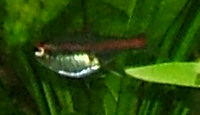
|
Green Tiger Barb
Barbus tetrazona
There were 6 of the green tiger barbs initially. They are an aggressive fish
and will chase each other. If any weaken, they are attacked.
This has led to deaths and injury despite segregation and treatment.
If the numbers diminish I always replace them with either green or regular
tigers right away to keep the numbers up!
The tigers have their own pecking order and
will also nip playfully at anything new. Care is needed when choosing
tank mates, although they tend to only chase each other! They are however
very attractive.
They will lock lips and spin around to decide the pecking order, as
shown in the bottom photo.
|
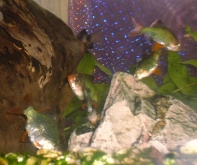
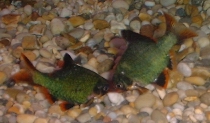
|
Guppy
Lebistes reticulatus / Poecilia reticulata
The Guppies were bought on a whim, when I decided they were exactly
what I needed when restocking my "pretty" tank. They get along well
with my tetras and harlequins, and are attractive.
I had 5 snakeskin guppies, which are all very slightly different
in colour, and one blonde which has a bright orange tail (right in the
top photo) and tends to be the bully. All of them are male, so that I don't
end up with hundreds of them! After being too fast for the pretty
tank they were put in the 4ft tank and held their own against tiger barbs.
|


|
Harlequin Rasbora
Rasbora heteromorpha
A pretty pinkish coloured fish with triangular black marking. Beautiful
in groups and remain quite small.
The male's black marking is triangular, the female's is more slightly
curved - although it can be hard to tell.
|
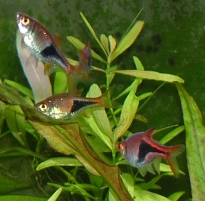
|
Hornet Cichlid
Pseudotropheus crabro
I bought a pair at the end of 2004, to liven up the tank while still
getting along with the existing residents. These two have grown fast
and largely keep themselves to themselves, but sometimes get a bit
nippy with other fish that get in their way when the food arrives!
They have chosen to live in a small cave.
|

|
Kribensis
Pelvicachromis pulcher
I have a pair of Kribs, both stunning in appearance. The male is the
larger one with longer fins.
Only 5 minutes after introducing them to the tank, the female had
hogged a coconut cave for herself, and then started bending left and
right and quivering, to initiate courtship
with the male. Quick work!
They are very interesting to watch, and seem peaceful with other
members of the tank, though they will give a clown loach a poke in
order to reach some tasty food.
They lay eggs, but so far none have hatched. I was given a juvenile
pair recently but they suddenly died within a week of each other, at
nine months old. All other fish are fine - most odd.
|
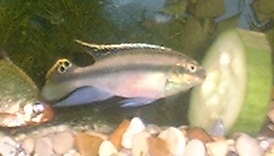

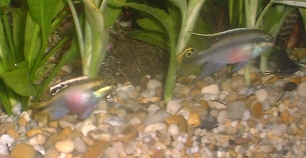
|
Moorii
Pseudotropheus Moorii
In 2006 I turned my large tank into a Malawi cichlid setup, and
bought a small group of these. They were the last three in the
tank and one has different markings.
Although they are the smallest fish in the tank, they are lively
and fun, more than capable of holding their own.
The photos show juveniles.
|
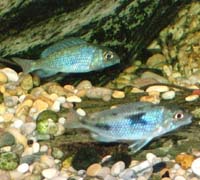
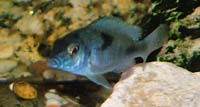
|
Kuhlii Loach
Pangio kuhlii
I bought a kuhlii, and he seemed lively and well in the shop. After a
careful acclimatisation I released him, and he buried himself in the
gravel. Next morning he was bloated and dead. Not one I will get again.
|
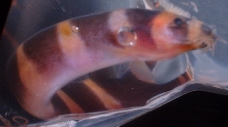
|
Pangasius Catfish
Pangasius sutchi
Two were added to the tank over a year after its creation, because
the existing fish were swimming at the bottom and I wanted something that
would use the top half of the tank as well. As Pangasius Cats are nearly
blind, they prefer to swim in the regions of the tank without rocks and
plants.
Soon after arrival both developed white spot which was successfully
treated. One developed an ulcer and died despite treatment. The other ("Pang")
has successfully been treated for eye fluke.
I am caring for Pang, but would not buy these fish again for an aquarium.
They are also highly strung and grow huge!
Update: Pang died 2004-01-24 after two years in my care. No symptoms.
|

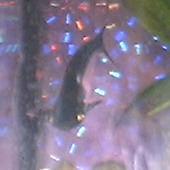
|
Peacock Cichlid
Aulonocara
I wanted to get some more cichlids for my tank and slowly turn it
into a cichlid tank as the other fish die off... the first choice was
peacocks, as they are relatively peaceful.
For a while I wasn't sure if I had a zebra obliquidens because it
did change colour, and it was quite aggressive
towards other fish when small, but when larger it became very peaceful
and withdrawn so I am assuming the original identification was right.
It's now an almost black colour.
Update: one died unexpectedly overnight in October 2004 after growing
to about 5". The other, and the rest of the tank, seem fine.
|
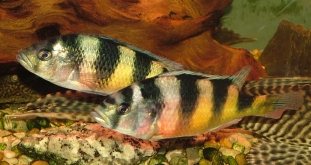
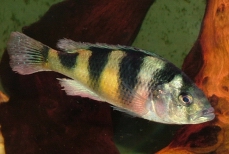
|
Plecostomus Catfish
Plecostomus
My suckermouth is the only fish to have a name - Algernon (Pleco 1, Algae None...)
- and was bought after the tank had been active for two months. He
settled straight away and overnight
had powered his way around and eaten much of the algae build up!
Luckily the other fish have accepted him and not pecked him at all. He
is gorgeous!
I have not yet identified what type of pleco he is, although
according to this
page the number of spines will tell you what species he is.
He has more than ten spines, but he will not stay still long with his fin up.
He eats everything and has grown quite big. He likes cucumber and celery,
but usually gets algae wafers instead as vegetables dirty the filter
very quickly.
In March 2004 I was given another, and it made the larger catfish move
up so it could sleep with them. During 2005 I found it another home
so my own Pleco wasn't overcrowded.
|

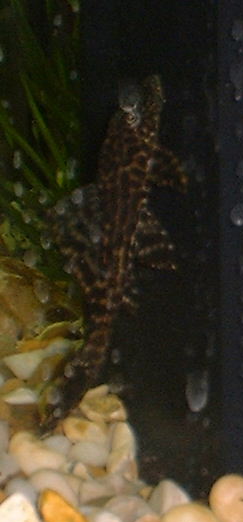
|
Powder Blue Cichlid
Pseudotropheus Socolifi
In 2006 I turned my large tank into a Malawi cichlid setup, and
bought a small group of these.
They shimmer beautifully in the tank, adding colour and interest.
The other cichlids are more active - these sit and watch the world
go by, in the middle of the open water.
The photo shows a juvenile.
|
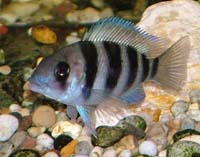
|
Red Cichlid
Pseudotropheus Estherae
I chose these to add colour to my Malawi Cichlid set up.
They have no distinctive markings but add orange colour
to the tank. Hey, it's a change from blue or yellow!
The photo shows a juvenile.
|

|
Red Tailed Black Shark
Epalzeorhyncus bicolor, Labeo bicolor
This was one of many fish given to me when a friend had to move house.
He's small, about an inch long, and has apparently never grown. I
tried him in my tetra tank, as the fish were the same size and I was
told he was very shy, but he soon chased them, so he is now in my
4ft tank. He is the smallest fish there, but he seems happy enough.
He is slowly starting to grow and he stands up to any fish that
bothers him.
|
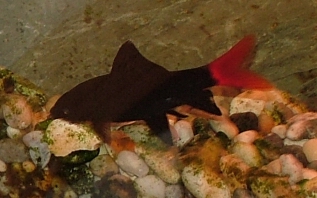
|
Silver Shark
Balantiocheilus melanopterus
I bought two sharks because I think they are gorgeous, and learnt that
they should live well with barbs, but they were more trouble than the others.
From the start they were highly strung, such that they would leap about and
occasionally knock themselves on the lid. They contracted White Spot when
none of the others were affected, although they responded well to treatment.
One of them took to hiding in a corner panting all day, so I put it down,
and a few weeks later the (apparently) healthy fish, which had always been
stronger, was found dead after a weekend away. They had lived just three
months in the tank, compared to their natural life span, and the other fish
have been in the tank for over a year at present. Although beautiful,
I would not wish to keep them again.
|

|
Taiwan Reef cichlid
Protomelas steveni taiwan reef
I wanted some more fish that were striped, could hold their own
in my tank, and wouldn't grow too big. These fish were recommended
to me by someone on a newsgroup.
I did my research and discovered that they are unimpressive looking
at a young age, but rewarding and attractive fish later on. This
was just as well, as those in the shop were babies without much
colour.
Females also keep this colour, so it's possible I have females,
however the shop were also convinced the colour will develop.
I'm looking forward to seeing it!
They won't stay still for a photo...
|


|
Tiger Barb
Barbus tetrazona
Regular stripey tigers, these behave the same way as the green tigers,
the only difference being colour variation. They will group happily
with the green tigers. They have the same orange and black fin colours
as the greenies.
|

|
Yellow Johannis
Melanochromis Johanni
I bought these in January 2006, labelled as Yellow Aceis, but
after a bit more research and advice I think they are female
Johannis (or juvenile males which are not yet showing their
true colour). They are quite amenable and not as agressive as
some of the other cichlids, but holding their own.
The photo shows a juvenile.
|
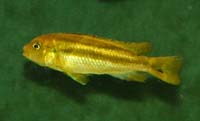
|
Yoyo Loach
Botia Lohachata
I have one yoyo loach, so named because the marking on their side appear
to spell the word "yoyo". (Also called Pakistani loach.) He is very active,
and is doing a very good job of clearing hair algae and dropped food from
my plants, which is a bonus!
|

|











![[B]Louis: Royal blue crowntail betta splendens](betta/trailing.jpg)





















































